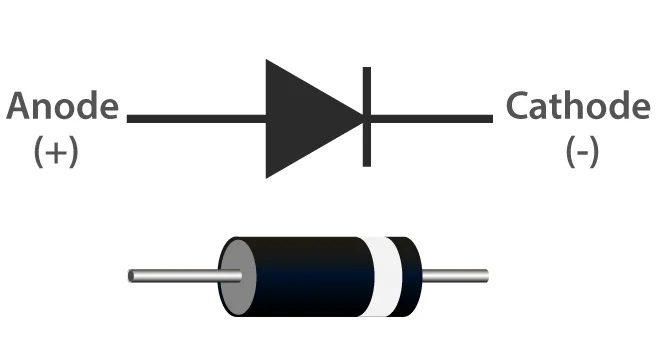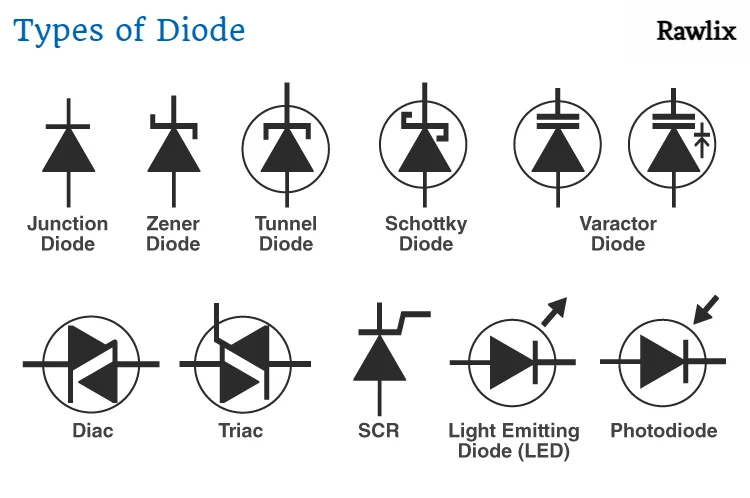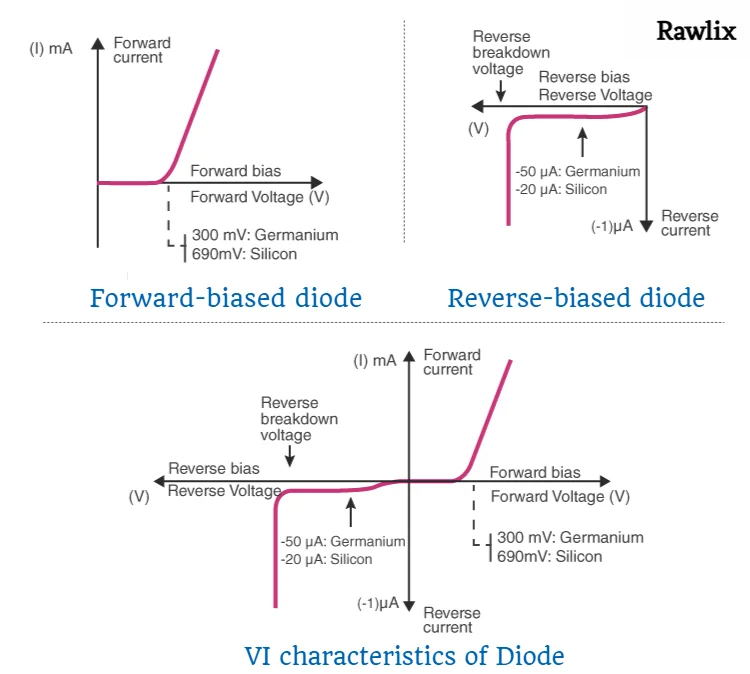Diodes
Building the circuit needs an understanding of numerous components, including resistors, transistors, diodes, inductors, capacitors, battery sources, and connecting wires. A diode is one of the circuit's primary components.
What is a Diode?
A diode is a two-terminal electronic component that conducts electric current primarily in one direction. It is made up of a semiconductor material, typically silicon, with impurities added to create positive and negative charge regions. The positive region called the p-side or anode, and the negative region, called the n-side or cathode, are separated by a thin region called the depletion region. Diodes can be used for a variety of purposes, such as rectifying alternating current to direct current, or as a switch or voltage limiter.
Diode Symbol

The symbol for a diode is a triangle pointing towards a vertical line, with the tip of the triangle touching the line. The vertical line represents the anode and the triangle represents the cathode. The direction of the current flow is indicated by an arrow pointing from the anode to the cathode.
Diode Construction
A diode is a two-terminal electronic device that allows current to flow in only one direction. It is constructed with a p-n junction, which is formed by joining a p-type semiconductor material (such as boron) with an n-type semiconductor material (such as phosphorus). The p-type material has an excess of holes (positive charge carriers) and the n-type material has an excess of electrons (negative charge carriers). When the p-n junction is formed, the holes and electrons combine at the junction, creating a depletion region where there are no charge carriers. This region acts as a barrier that prevents current from flowing in the reverse direction.
The p-n junction is usually enclosed in a small glass or plastic package to protect it from damage and to make it easy to connect to a circuit. The anode terminal is connected to the p-type material and the cathode terminal is connected to the n-type material. When a forward voltage is applied across the diode, the depletion region becomes thin, and current can flow through it, allowing the diode to conduct. When a reverse voltage is applied, the depletion region becomes thick, and current cannot flow through it, making the diode non-conductive.
This article tells you everything you need to know about the different kinds of diodes.
Types of Diodes
There are many different types of diodes, each with its own unique characteristics and applications. Some of the most common types include:

PN Junction Diode
PN Junction diode is the basic and most common type of diode. It is formed by joining a p-type semiconductor with an n-type semiconductor. It is a two-terminal device that allows current to flow in only one direction. The p-n junction diode is a versatile device that is used in many applications, including rectification, clipping, and switching.
Zener Diode
A Zener diode is a type of p-n junction diode that is designed to operate in the reverse breakdown region. When a Zener diode is reverse-biased, the voltage across it remains constant regardless of the current flowing through it. This makes it useful for voltage regulation and voltage reference applications.
Light-Emitting Diode (LED)
A light-emitting diode (LED) is a type of diode that emits light when current flows through it. They are made of semiconductor material and are used for many applications, such as indicator lights, displays, and lighting. LEDs are more energy efficient and longer lasting than traditional incandescent bulbs.
Schottky Diode
A Schottky diode is a type of diode that is made of a metal-semiconductor junction rather than a p-n junction. Because of this, it has a lower forward voltage drop and faster switching times than a typical p-n junction diode, making it useful for high-frequency applications.
Varactor Diode
A varactor diode is also called as varicap diode. It is a type of p-n junction diode that can be used as a voltage-controlled capacitor. It is used in many applications such as frequency modulation, frequency multipliers, and phase-locked loops.
Tunnel Diode
Tunnel diode is a special type of diode that exhibits negative resistance. It is used in high-frequency and high-speed applications, such as microwave and millimeter wave systems, as well as in oscillators and amplifiers.
Photodiode
A photodiode is a type of diode that generates current when exposed to light. Photodiodes are used in many applications including light detection, digital imaging, and optical communications.
Avalanche Diode
An avalanche diode is a type of p-n junction diode that is designed to operate in the breakdown region. It is used in applications such as voltage clamping, over-voltage protection, and switching.
Characteristics of Diode
The characteristics of a diode can be described by its I-V (current-voltage) curve, which shows the relationship between the current flowing through the diode and the voltage across it. Some of the key characteristics of a diode include:

Diode Applications
Diodes have many applications in electronic circuits. Some of the most common applications include:
FAQs
Can a diode be used as a rectifier?
Yes, a diode can be used as a rectifier.
What is diode?
A diode is a two-terminal electronic device, it allows current to flow in only one direction. It is made of semiconductor material, mainly silicon or germanium.
Which is the diode used in solar cells and photometers?
The diode typically used in solar cells and photometers is a photodiode.
Name the diode which has the ability to produce coherent light?
A laser diode (LD) is a diode that has the ability to produce coherent light.
Which type of semiconductor are used in manufacturing diodes?
Diodes are typically made from silicon or germanium semiconductors.
Bottom Line
In conclusion, diodes are essential components in electronic circuits and play a vital role in converting AC to DC power, rectifying signals, and protecting circuit components from voltage spikes. They are widely used in a variety of applications such as radios, televisions, power supplies, and computer systems. Understanding the basic principles of diodes and their characteristics is crucial for designing and troubleshooting electronic circuits. With the advancement of technology, new types of diodes, such as LED and laser diodes, have been developed and are being used in a wide range of applications, from lighting to communications. Overall, diodes are a simple yet powerful technology that plays an important role in modern electronics.














